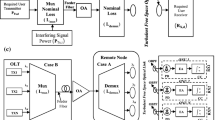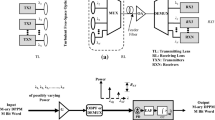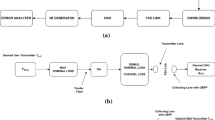Abstract
In this paper, we propose and enhance the performance of a wavelength-division multiplexed hybrid fibre/free-space optics passive optical network (PON) system. The proposed system makes use of digital-pulse-position modulation scheme. The system performance is investigated under the turbulence effects and inter-channel crosstalk using numerical simulations. The proposed system can be deployed in regions where the installation of optical fibre cables is not feasible and also for application in indoor limited-mobility transmission. The results demonstrate that the performance of hybrid fibre/PON link is degraded due to the atmospheric scintillation and amplified spontaneous emission (ASE) noise. Further, we have investigated the performance degradation induced in the proposed system due to ASE noise resulted from optical amplification. A link range varying from 0.5 to 5 km is achieved using the proposed system under varying weather conditions.
Similar content being viewed by others

Avoid common mistakes on your manuscript.
1 Introduction
An exploding requirement for channel bandwidth has been witnessed in the past years as a result of rising usage of broadband services and user applications (Yeh et al. 2018). Optical information transmission systems can be considered as a front-runner technology since they offer extremely high channel bandwidth (Kunert et al. 2017). Traditional copper wire-based access network architecture has been gradually replaced by passive optical networks (PONs) based on optical fibre cables. The fibre cables offer numerous merits as compared to traditional copper cables including less deployment cost, no problem of electromagnetic interference, and very low power consumption (Goyal et al. 2020). Conventionally, time-division multiplexed (TDM) systems were prominent technologies for the deployment of PON. But TDM-based PON architectures can only provide services to a limited number of end user optical network units (ONU) (Kumari et al. 2021). Wavelength-division multiplexed (WDM) systems are capable of connecting a greater number of ONUs along with high data transmission rates by dedicating a distinct wavelength for each ONU in order to establish a direct link between the central office (CO) and the optical-line terminal (OLT) unit. The bandwidth efficiency and data security in the case of WDM-PON architectures is much higher than in the case of TDM-PON architectures (Kumari et al. 2019). Digital pulse-position modulation (DPPM) is one of the most popular modulation techniques employed in both optical fibre and optical wireless communication (OWC) links. DPPM has been extensively employed in fibre networks for providing high-bandwidth services like video-on-demand, video-conferencing, online-telephony, internet protocol television, and social networking. In order to meet the explosive demand for channel bandwidth, dense WDM (DWDM) transmission has been explored for optical fibre and optical wireless networks for both indoor and outdoor applications. WDM transmission in PON is further considered as a promising technological solution for providing high data transmission rates and large bandwidth for future generation optical access network with enhanced security and high reach. DWDM transmission utilizes the 1528–1568 nm wavelength band and support up to 32 signals on one fibre with 200 GHz adjacent channel spacing. Free-space optical (FSO) networks can wirelessly transmit the data between two end points and have been successfully implemented for short-range applications (up to 4 km). In comparison to optical fibre transmission, FSO transmission offers numerous advantages including lower cost of installation and deployment, relatively easier installation process, lower foot print, and redeploy ability (Singh and Malhotra 2020, 2019; Amphawan et al. 2019; Chaudhary and Amphawan 2018). FSO transmission further offers many advantages over traditional radio frequency-based information transmission including enhanced security, no licensing need, and faster transmission speed. Although the FSO transmission merits are numerous, yet they are faced with many challenges including weather induced attenuation and turbulence induced scintillation effects, which degrade the transmission performance (Badar et al. 2018; Jeyaseelan et al. 2018a). A distribution network based on FSO transmission is a realistic and feasible technological solution for future access network as both fibre and FSO transmission employ the same components and carrier wavelengths (Jeyaseelan et al. 2018b). Further, the hybridization of both these technologies can results in a cost-effective and highly reliable optical access networks capable of meeting the future generation networks requirements (Jaffer et al. 2021; Mai and Pham 2015). However, the amplified spontaneous emission noise (ASE) noise resulted due to the amplification of optical signal bearing information by the amplifiers can result in the degradation of the proposed network performance and can complicate the transmission characteristics (Aladeloba et al. 2012). Inter-channel interference is another cause of signal degradation in the WDM transmission networks. The works reported by the authors in Phillips et al. (2001) discuss the performance degradation in WDM transmission networks due to inter-channel interference. Moreover, the information signal degradation due to turbulent behavior of free-space channel in the hybrid fibre/FSO access network will further degrade the performance of the proposed network and result in limiting the achievable transmission speed and range. The possibility of higher crosstalk power as compared to the information signal power can result in severe performance limitation (Elsayed et al. 2018). In this article, a novel hybrid fibre/FSO-based WDM-PON network is proposed and investigated under effects of turbulence and inter-channel interference noise. Further, to improve the performance, DPPM modulation is incorporated in the proposed scheme and the performance is evaluated for both upstream and downstream transmission. Moreover, the system performance is also investigated under varying levels of weather conditions.
2 Network (down/up) stream transmission
Figures 1 and 2 demonstrate the downstream and upstream transmission network architecture respectively which comprises of a transmitter unit including a laser diode for optical carrier generation, information signal (data), and PPM modulator. The receiver section consists of a photodiode (PD), amplifier and a decision circuit. The proposed system is based on intensity modulation/direct detection technique. For downstream data communication, optical signal from the OLT is separated to N signals, where each signal belongs to a distinct ONU. The maximum laser power for downstream transmission is limited to 10 dBm to minimize fiber non-linearities. The architecture of downstream transmission is similar to that of upstream transmission but the functionality is not the same. In comparison to the upstream transmission, downstream transmission has an additional loss in terms of power splitting.
In the upstream transmission, a dedicated transmission from the ONU to the OLT is implemented with a distinct laser having a specific wavelength. The information from the ONU to MUX (multiplexer) is transmitted through the distribution network (free-space channel), as shown in Fig. 2. The DEMUX (de-multiplexer) at the OLT separates distinct wavelengths. The optically encoded data signals from different ONUs location including households, buildings, and curb etc. are transmitted in the upstream direction through the free-space channel towards the remote node. The receiver lens captures the incident optical beam and then using a fiber collimator, directs it towards the input of a MUX. An optical amplifier is employed for transmission range improvement. A PIN diode after the DEMUX converts the information-bearing optical beam into an electric signal. A decision circuit based on integrate-and-dump is used to retrieve the information signal.
3 Turbulence channel modeling
The variations in the refractive index profile of the air along the optical signal path, as a result of changes in temperature results in atmospheric scintillation. This causes fluctuations in the optical signal intensity at the receiver, thus resulting in a poor bit-error rate (BER) of the system (Ghassemlooy et al. 2008). Gamma-Gamma (GG) model for turbulence is accepted for characterizing different levels of turbulence (weak, moderate, and strong) and is mathematically given as:
where \(h_{X}\) denotes the weather induced attenuation for the signal \({(}h_{{{\text{sig}}}} {)}\) or interferer \({(}h_{{{\text{int}}}} {)}\), \(\alpha\) and \(\beta\) denotes the number of large-scale and small-scale eddies respectively (Eqs. 2 and 3), and \(K_{n} \left( \cdot \right)\) denotes the gamma function.
where \({\text{d}} = \sqrt {KD_{RX}^{2} /4l_{fso} }\) denotes the normalized receiver radius, \(D_{RX}\) is the diameter at the receiver lens, and \({\upsigma }_{{\text{R}}}^{{2}} = {1}{\text{.23C}}_{{\text{n}}}^{{2}} {\text{k}}^{{{\raise0.7ex\hbox{${7}$} \!\mathord{\left/ {\vphantom {{7} {6}}}\right.\kern-\nulldelimiterspace} \!\lower0.7ex\hbox{${6}$}}}} l_{fso}^{{{\raise0.7ex\hbox{${{11}}$} \!\mathord{\left/ {\vphantom {{{11}} {6}}}\right.\kern-\nulldelimiterspace} \!\lower0.7ex\hbox{${6}$}}}}\) is the Rytov variance (Aladeloba et al. 2012).
4 BER analysis
This section reports the BER investigation results of the proposed scheme using numerical simulations. The average BER under fixed levels of transmission power, channel crosstalk, and signal attenuation can be presented in mathematical form as (Aladeloba et al. 2012):
where \(p_{{\text{GG,sig}}} {(}h_{{{\text{sig}}}} {)}\) and \(p_{{\text{GG,sig}}} {(}h_{int} {)}\) denote the signal and interferer GG pdfs respectively (having different values of different \(\alpha {, }\beta {,}\,{\text{ and }}\,{\upsigma }_{{\text{R}}}^{{2}} {)}\). Figure 3 reports the BER performance for weak and strong turbulence conditions without amplification.
The error floor in the case of weak atmospheric conditions occurs at a lower BER range using 30 dB signal-to-crosstalk (\({\text{C}}_{\text{XT}}\)) ratio. For no-amplification case as reported in Fig. 3, the S, turbXT (interferer along with turbulence) and the turbS, XT (interference without turbulence) are the same, as the value of instantaneous crosstalk ratio has the same statistics. But in the case of S, turbXT, there is no variation in the ratio between the signal and the noise power whereas in turbS, XT there will be large variations (Ghassemlooy et al. 2008). The same trend can be observed while deploying an amplifier in the optical path (Fig. 4).
When there is a dominant interferer, the single crosstalk can be used. The received power at the OLT photodiode is provided as equations expressed in Aladeloba et al. (2012):
where \({\text{L}}_{{\text{demux,XT}}}\) denotes the additional loss, the interferer suffers after DEMUX. \({\text{P}}_{{\text{UT,sig}}}\) and \({\text{P}}_{{\text{UT,int}}}\) denote the ONU transmission power for information signal and interferer, \({\text{.L}}_{{{\text{fiber}}}} { = 10}^{{\left( { - \propto_{{\text{(fiber)}}} /{10}} \right)}}\) represents the loss in the fiber due to attenuation. The geometric loss \({\text{L}}_{{{\text{bs}}}}\) in the FSO link can be calculated from Ghassemlooy et al. (2008):
The coupling loss \({\text{L}}_{{\text{C}}}\) can be calculated as (Ghassemlooy et al. 2008):
where \(\alpha\) is the ratio of the receiver radius to that of the back-propagated fibre mode and \(A_{RX} = \frac{{\pi D_{RX}^{2} }}{4}\), is the receiver area.
The BER and Q Factor for downstream transmission is given by Aladeloba et al. (2012):
The received power at the ONU for information and interferer signal are given respectively, as (Aladeloba et al. 2012):
where \({\text{ P}}_{{\text{dR,sig}}} {\text{and P}}_{{\text{dR,int}}}\) are the OLT transmitter power and can used for the electric domain noises (Ghassemlooy et al. 2008).
The performance of the proposed hybrid fibre/FSO WDM-PON system is investigated under different channel conditions. Table 1 exhibits the parameters taken while performing simulations.
Figure 5 shows the downstream required transmitted optical power (dBm) at target BERs of \({ 10}^{{ - {6}}}\) as a function increase FSO range, for no interferer and single interferer cases with \(l_{demux} = 15\,{\text{dB}}\). From the results, it is observed that as the turbulence strength increases, the BER performance degrades for both single interferer and no interfere cases. Further, it is observed that if the power is increased beyond 10 dBm, it can compensate for all the levels of atmospheric turbulence conditions. For 10 dBm transmission power, 2000 m FSO range is achieved at BER of 10–12.
Figure 6 reports the requirement of upstream data transmission power with increasing FSO range at a target BER of \({ 10}^{{ - {6}}}\). It can be observed that for both the case of no interferer and single interferer, as the FSO length increases, the required power increases. Further, as the turbulence conditions get worse, the required power increases. Moreover, if the power is increased to 20 dBm, which is within the eye safety concern, it maximum achievable FSO range is 2000 m.
Figure 7 reports the variation of SNR at the receiver with increasing transmission range for varying weather conditions. Table 2 tabulates the results presented in Fig. 7.
5 Conclusions
We investigated a hybrid fibre/FSO based WDM-PON network using DPPM scheme under the effects of atmospheric turbulence and inter-channel interference. From the results, it is observed that scintillation effects, amplified spontaneous emission noise, and inter-channel crosstalk results in severe signal degradation, particularly in upstream data transmission, which results in increasing the BER of the system. The ASE noise and inter-channel crosstalk analysis are calculated for the proposed network using the DPPM modulation. The results report faithful transmission along range varying from 0.5 to 5 km, depending on external weather conditions. The proposed scheme can be deployed for low-cost front-haul network for 5th generation CRAN architectures.
Data availability
Not applicable.
References
Aladeloba, A.O., Phillips, A.J., Woolfson, M.S.: Improved bit error rate evaluation for optically pre-amplified free-space optical communication systems in turbulent atmosphere. IET Optoelectron. 6, 26–33 (2012)
Aladeloba, A.O., Phillips, A.J., Woolfson, M.S.: DPPM FSO communication systems impaired by turbulence, pointing error and ASE noise. In: 14th International Conference on Transparent Optical Networks (ICTON), pp. 1–4 (2012)
Amphawan, A., Chaudhary, S., Chan, V.: Optical millimeter wave mode division multiplexing of LG and G modes for OFDM Ro-FSO system. Opt. Commun. 431, 245–254 (2019)
Badar, N., Jha, R., Towfeeq, I.: Performance analysis of 80 (8 × 10) Gbps RZ-DPSK based WDM-FSO system under combined effects of various weather conditions and atmospheric turbulence induced fading employing Gamma-Gamma fading model. Opt. Quant. Electron. 50, 1–11 (2018)
Chaudhary, S., Amphawan, A.: Selective excitation of LG 00, LG 01, and LG 02 modes by a solid core PCF based mode selector in MDM-Ro-FSO transmission systems. Laser Phys. 28(7), 1–8 (2018)
Elsayed, E.E., Yousif, B.B., Alzalabani, M.M.: Performance enhancement of the power penalty in DWDM FSO communication using DPPM and OOK modulation. Opt. Quantum Electron. 50(7), 282 (2018)
Ghassemlooy, Z., Popoola, W., Rajbhandari, S.: Optical Wireless Communications System and Channel Modelling with MATLAB®. CRC Press, Boca Raton © 2013 by Taylor & Francis Group, LLC CRC Press is an imprint of Taylor & Francis Group, an Informa business. International Standard Book Number-13: 978-1-4398-5235-4 (eBook - PDF) (2008).
Goyal, S., Kaler, R.S., Singh, H.: Performance analysis of multicore multimode fiber for passive optical network. Microw. Opt. Technol. Lett. 62, 3030–3037 (2020)
Jaffer, S.S., Hussain, A., Qureshi, M.A., Mirza, J., Qureshi, K.K.: A low cost PON-FSO based fronthaul solution for 5G CRAN architecture. Opt. Fiber Technol. 63, 102500 (2021). https://doi.org/10.1016/j.yofte.2021.102500
Jeyaseelan, J., Kumar, S., Caroline, B.: PolSK and ASK modulation techniques based BER analysis of WDM-FSO system for under turbulence conditions. Wirel. Pers. Commun. 103(4), 3221–3237 (2018a)
Jeyaseelan, J., Kumar, S., Caroline, B.: Performance analysis of free space optical communication system employinh WDM-PolSK under turbulent weather conditions. J. Optoelectron. Adv. Mater. 20(9), 506–514 (2018b)
Kumari, M., Sharma, R., Sheetal, A.: Comparative analysis of high speed 20/20 Gbps OTDM-PON, WDM-PON and TWDM-PON for long-reach NG-PON2. J. Opt. Commun. (2019). https://doi.org/10.1515/joc-2019-0005
Kumari, M., Sharma, R., Sheetal, A.: Performance evaluation of symmetric 8 × 10 Gbps TWDM-PON incorporating polarization division multiplexed modulation techniques under fiber-impairments. Wirel. Pers. Commun. 121, 1995–2010 (2021)
Kunert, K., Jonsson, M., Böhm, A., Nordström, T.: Providing efficient support for real-time guarantees in a fibre-optic AWG-based network for embedded systems. Opt. Switch. Netw. 24, 47–56 (2017)
Mai, V.V., Pham, A.T.: Integrated FSO/PON for broadband access networks: a comprehensive protocol stack design and analysis. In: 2015 IEEE Global Communications Conference (GLOBECOM), pp. 1–7. https://doi.org/10.1109/GLOCOM.2015.7417553 (2015)
Phillips, A.J., Senior, J.M., Mercinelli, R., Valvo, M., Vetter, P.J., Martin, C.M., Van Deventer, M.O., Vaes, P., Qiu, X.Z.: Redundancy strategies for a high splitting optically amplified passive optical network. J. Lightwave Technol. 19, 137–149 (2001)
Singh, M., Malhotra, J.: Enhanced performance of 40Gbit/s-80GHz OFDM based radio over FSO transmission link incorporating mode division multiplexing under strong atmospheric turbulence. Optoelectron. Adv. Mater. Rapid Commun. 13, 437–447 (2019)
Singh, M., Malhotra, J.: 40Gbit/s-80GHz hybrid MDM-OFDM-Multibeam based RoFSO transmission link under the effect of adverse weather conditions with enhanced detection. Optoelectron. Adv. Mater. Rapid Commun. 14, 146–153 (2020)
Yeh, C.-H., Chong-Sin, Gu., Guo, B.-S., Chang, Y.-J., Chow, C.-W., Tseng, M.-C., Chen, R.-B.: Hybrid free space optical communication system and passive optical network with high splitting ratio for broadcasting data traffic. J. Opt. 20, 125702 (2018)
Funding
None.
Author information
Authors and Affiliations
Corresponding author
Ethics declarations
Conflict of interest
The authors declare that they have no conflict of interest.
Additional information
Publisher's Note
Springer Nature remains neutral with regard to jurisdictional claims in published maps and institutional affiliations.
This article is part of the Topical Collection on Photonic Integrated Circuits for High-Speed Optical Networks.
Guest edited by Shanmuga Sundar Dhanabalan, Marcos Flores Carrasco, Rajesh M. Sanjivani, Arun Thirumurugan and Sitharthan R.
Rights and permissions
About this article
Cite this article
Elsayed, E.E., Alharbi, A.G., Singh, M. et al. Investigations on wavelength-division multiplexed fibre/FSO PON system employing DPPM scheme. Opt Quant Electron 54, 358 (2022). https://doi.org/10.1007/s11082-022-03717-5
Received:
Accepted:
Published:
DOI: https://doi.org/10.1007/s11082-022-03717-5










